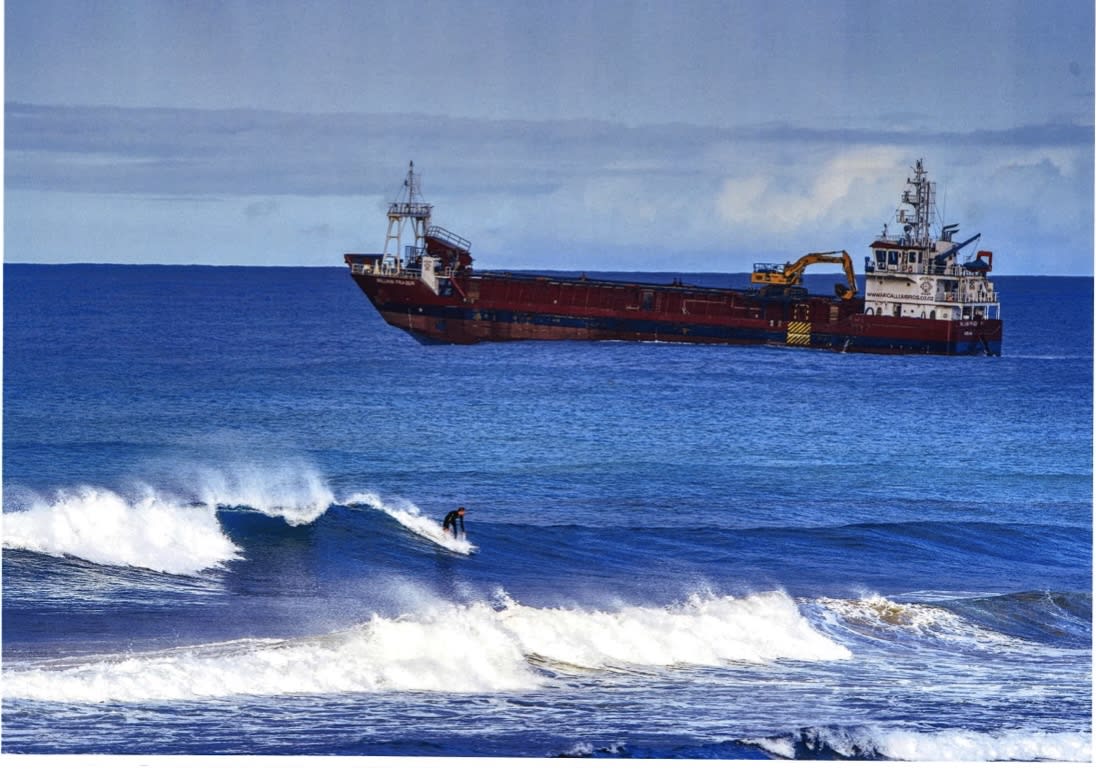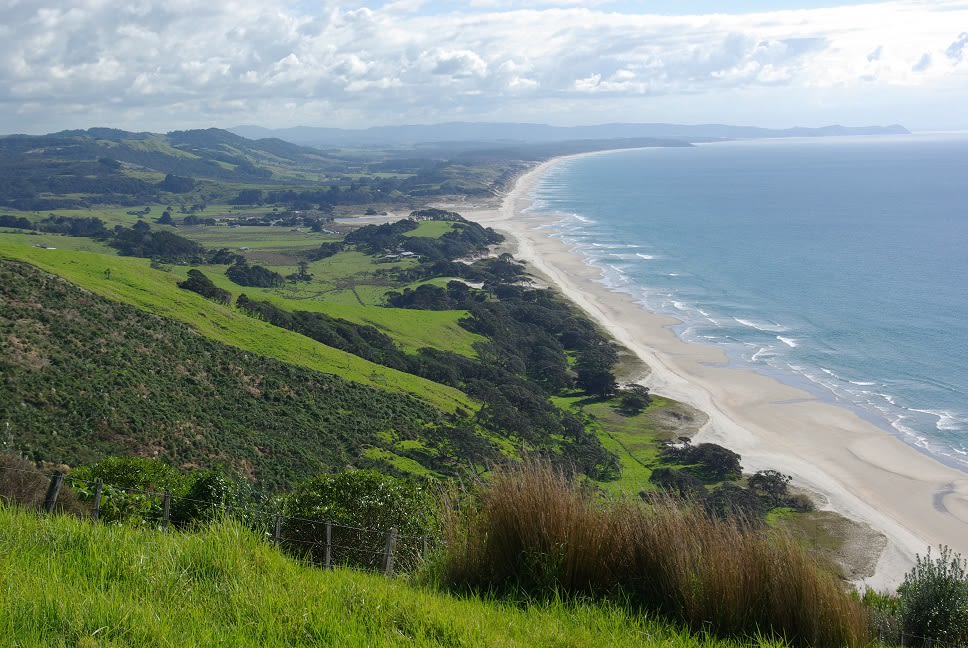
At the very end of a weeks-long resource management hearing, dredging company McCallums has volunteered a reduction in sand volumes and a hike in royalties as it attempts to get its licences to mine beach sand renewed
Time, if you measure it by volume of sand, is running out for Pakiri beach, an area of wild natural beauty north of Auckland. Or that’s what local environmentalists argue. A consent for Auckland dredging company McCallum Brothers to mine Pakiri sand lapsed two years ago, but dredging continues, despite evidence of breaches, they say. And that's turning the seabed north of Goat Island marine reserve into rocks and rubble.
Not true, says McCallum.
In a final twist to a complex, technical (and emotional) six-week resource management hearing, the company on the second-to-last day offered a last-ditch compromise proposal; it would mine less sand over fewer years, with more monitoring and double the royalties to iwi - from 50 cents to $1 per cubic metre of sand.
McCallum managing director Callum McCallum said this was to mitigate the effect of its operations.
Now it’s up to Auckland Council to come to a decision.
At stake is a stretch of water and seabed off the east coast of the North Island, known as the Mangawhai-Pakiri Embayment. The Auckland Unitary Plan identifies the beach as a marine “Significant Ecological Area” and above sea-level, activity is highly restricted.
But despite these classifications, the seabed at Pakiri has been mined for around 80 years, with an estimated 6-10 million cubic metres of sand being extracted.

The latest hearing, which closed on September 1, involves two McCallum sand mining applications – for sand to be taken from the seabed close to the shore, and a bit further out. A third application, for sand further out still, was turned down by Auckland Council in a decision in May and is being appealed by McCallum. That case will be heard by the Environment Court next February.
Between the three applications McCallum is looking to take up to nine million cubic metres of sand over the next 35 years.
It’s hard to visualise nine million cubic metres of sand, but maybe it helps to know that one of those trailers you hire to bring soil or compost - or sand - back from the building supplies store holds about half a cubic metre.
READ MORE:
► Sand mining: What’s yours is mined
So McCallum wants to take 18 million trailer loads of sand from the Pakiri coastline over 35 years. As we said in our previous story, maybe that comparison doesn’t help much, but suffice to say it’s more sand than has ever been taken before.
McCallum argues the Pakiri sand is crucial to meet Auckland’s growing demand for homes and infrastructure.
“Everyone seems to profit from the sale of our lands. In addition to the profit made by the sand miners, the Crown takes a royalty, the NgatiWai Trust Board takes a royalty, Auckland industry gets our sand and we are left on the beach with our people to try and care for the area.” – Mook Hohneck, Ngāti Manuhiri
“Currently Auckland produces about 1.8 million cubic metres of pre-cast and ready-mix concrete. This requires approximately 790,000 tonnes of sand on an annual basis,” the company says on its website.
“McCallum Bros supplies at least 45 percent of that volume."
Pakiri sand gives the Auckland construction industry confidence of “an ongoing and reliable supply of sand to produce the concrete needed to support continued infrastructure development required by a growing city”, McCallum says.
Decades of division
Still, the number of submissions against the mining application far outweigh those in favour and tell a story of disillusioned residents, iwi and conservationists trying to stop a well-supported business.
As Terrence (Mook) Hohneck, chair of the Ngati Manuhiri Charitable Trust, said in his submission:
“Everyone seems to profit from the sale of our lands. In addition to the profit made by the sand miners, the Crown takes a royalty, the NgatiWai Trust Board takes a royalty, Auckland industry gets our sand and we are left on the beach with our people to try and care for the area.”
Tangata whenua Te Whānau o Pakiri, Ngati Paoa Te Iwi, Ngati Wai, Ngati Manuhiri and others say they are tired of fighting the same fight every few decades. They are tired of having to introduce themselves to visiting Commissioners and explain their relationship to the land and the sea. And they say they are tired of using funds granted in settlement by the Crown to protect land already meant to be protected.

Meanwhile wildlife interests and local groups Friends of Pakiri Beach (FOPB) and Save our Sands say the sea floor has been so decimated by repeated dredging it will take decades to restore. FOPB representative Damon Clapshaw resorted to satellite positioning data to monitor the overnight movements of McCallum Brothers’ dredge.
He says he demonstrated three years ago that the suction machine was working the same location repeatedly, against the conditions of the permit.
Permit expired, but mining continues
What also frustrates opponents is that the first permit - to take 70,000 cubic metres of sand a year from close to the shore (5-10 metres depth) - expired in September 2020. But the Resource Management Act (RMA) allows mining to carry on until a decision has been made on renewing the permit.
The second application is for a whole new permit to mine the mid-shore (a depth of 15-25m), removing the same amount of sand.
In May this year, a third application, to renew the existing offshore permit, was refused by independent commissioners. The permit was due to expire in November next year and allows for the extraction of 2 million cubic metres of sand over 20 years.
But an appeal to the Environment Court means mining can carry on, despite the decision to stop it. That means 150,000 cubic metres of sand can be taken from a depth of 25m each year until the matter is resolved.
And so the McCallum Brothers vessel, the William Fraser, continues its nightly extraction along the coastline under these two contested permits, one of them now two years out of date.
In declining to extend the offshore permit in May this year, commissioners expressed doubts about the reliability of some of the McCallum’s evidence, specifically an earlier bathymetric (sea floor) survey.

After multiple complaints by submitters that the sand miners were dredging more than allowed, the McCallum Brothers’ experts admitted non-compliance had occurred. An expert coastal processes group had discovered some trenches up to 2.4m deep back in 2020.
Commissioners said non-compliance was for Auckland Council monitoring to address.
An Auckland Council spokesperson says since then it has “worked with the consent holder to adopt an improved method of operation that will ensure any effects are remediated effectively”.
The “improved method of operation” means the sand miners must temporarily exclude the area where the repeated trench lines were found and, effectively, move on.
In his submission, coastal geomorphologist Derek Todd suggested, on behalf of McCallum Brothers, this method could be adopted as a condition of any future consent. He explained the benefits of an increased dredging area (from 2.7 to 6.6 sq kms) should the applications for inshore and mid-shore permits be approved.
“A positive effect from increasing the extraction area is that the frequency of needing to extract from the same track location decreases, allowing more time for seabed recovery and increasing the likelihood that the track will totally infill before being re-dredged.
“This in turn reduces the risk of premature change in bed levels with extraction.”
Council ignores non-compliance
Following an Official Information Act request, opponents presented McCallum’s sand volume reports to the commissioners at the RMA consent hearing.
They showed day after day exactly the same volume of sand - 450 cubic metres - reportedly dredged from Pakiri beach.

Kerry Flynn, Auckland Council’s compliance monitoring team leader Northern, says his team accepts the figures it is given, unless it has “substantive evidence” the data isn’t accurate.
He says his team hasn’t changed its processes, despite McCallum admitting non-compliance at the far shore hearing.
Councillor Alf Filipaina, Chair of Auckland Council's Parks, Arts, Community and Events Committee says matters of non-compliance are for officials to manage. He was unwilling to explain how he reconciled the sand mining with the area’s ecological significance while the hearing was going on.
At the end of the hearing, McCallum Brothers were asked whether the data from their newly-proposed compliance monitoring model would be evaluated by Auckland Council.
“It’s not a matter for evaluation by Council,” John MacRae for McCallum Brothers responded.
“It’s essentially a numbers exercise. The results as I understand it are not really open to debate.”
DOC says McCallum approach 'fatally flawed'
The latest round of hearings has again sought hard data. It has largely been a tit-for-tat, your expert versus mine. There were also debates about whether sand is a finite resource, derived from an ancient offshore volcano, as one submitter suggested.

On the other side, McCallum Brothers argues it’s constantly re-generating, pointing to sediment reports. The company’s website, thenittygritty.co.nz describes Pākiri sand as unique. It has also suggested the beaches along the coastline have grown rather than receded over the decades, citing aerial photographs among other expert evidence.
That’s enough to drive the locals mad. At one of the meetings, held in the Pakiri Hall during August, impassioned submitters were worried their photographs and 40 years of first-hand experience might be relegated to the “anecdotal only” pile by Commissioners, in the face of the “science” presented by the applicants.
“The Applicant starts with the maximum extraction and sees what happens. The Panel is not given reasonable assurance that their approach will sufficiently reduce uncertainty and adequately manage remaining risk.” – Lisa Sutherland, DOC
The other point of contention has been over what counts as ‘truly sustainable’. Thenittygritty.co.nz says the company takes its obligation to minimise its impact on the environment seriously.
“The research has found sand extraction in the embayment has a less than minor environmental and ecological impact and, with continued careful management and appropriate monitoring, sand can be extracted with minimal environmental impact into the future,” the homepage says.
The Department of Conservation (DOC), in its submission, took issue with McCallum’s claims. On behalf of the Director General of Conservation, lawyer Lisa Sutherland said the applicants’ “adaptive approach” to sand extraction was “fatally flawed”.
“The Applicant starts with the maximum extraction and sees what happens. The Panel is not given reasonable assurance that their approach will sufficiently reduce uncertainty and adequately manage remaining risk,” Sutherland said.
“You must decline both applications.”
McCallum managing director Callum McCallum declined to be interviewed during the hearing.







